Agricultural Economics - Agricultural Sciences Grade 10 Study Guide
Share via Whatsapp Join our WhatsApp Group Join our Telegram GroupUNITS
- OVERVIEW
- Unit 1 Agricultural economics – the global situation
- Unit 2 Agricultural economics in South Africa
- Unit 3 Land distribution and reform
- Unit 4 Agricultural legislation
- Unit 5 Agricultural organisations
- Unit 6 Indigenous knowledge in South Africa
- Topic questions
TOPIC 2: AGRICULTURAL ECONOMICS
Overview
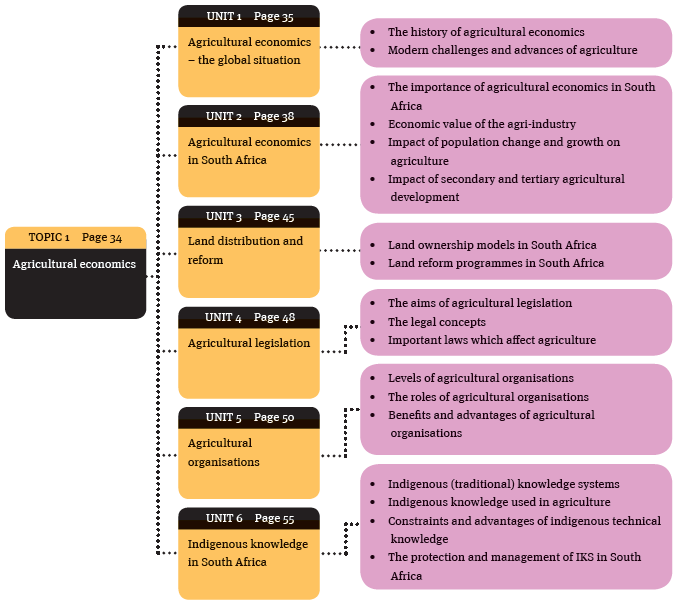
What you will cover in Topic 2
Agriculture is the most important primary industry in any country of the world:
- It supplies the real needs of the people and it is a key economic driver for individual livelihoods, poverty alleviation and our nation’s economic growth.
- Countries must examine population growth, the economic value of food products and the industries that arise from agriculture and contribute to the economy. It is important for countries to do this so they can plan for problems regarding food security, providing employment and earning foreign exchange.
- Trends (population growth and shift, global demand and climate predictions) help government to make agriculture policies to help ensure food security.
- Farmers study which products are best suited to their circumstances and are in demand, the government legislation, agricultural policies, assistance programmes and organisations to help ensure the success of their agricultural ventures.
Unit 1: Agricultural Economics - The Global Situation
1.1 The history of agricultural economics
Civilisation started with the development of agriculture: resulted in the development of tools and methods of production.
- The domestication of plants started about 10 000 years ago (the Neolithic Age) when the hunter-gatherers first began growing crops in Mesopotamia (today called Iraq) followed by Egypt.
- Then came the domestication of animals for food (meat, milk and eggs), clothing (leather), for draught power, to assist with hunting and for companionship. At first, agriculture was simple subsistence farming.
- Pastoralists developed when the areas settled became overgrazed and the soil exhausted. They migrated to new, unsettled areas where they may also have planted new crops. Once these pastures and / or soil were exhausted, they moved on again. As methods of production improved, surplus product (usually food in the form of crops or animals) was produced for the family or clan. This could be bartered or sold for money. Those that produce surplus crops for sale are called cash croppers.
- The domestication of crops and animals led to urbanisation. Food was brought to urban areas and sold. The urban dwellers had to produce or manufacture other goods or services in order to buy or barter for food.
- Methods of production improved as science enabled a better understanding of the environment, the basic inputs of agriculture, of breeding, of how to control pests, parasites and diseases, mechanisation and how to market the produce.
- This led to both the intensification and commercialisation of agriculture where the production of food, fibre and the other primary products became a business and making a profit the major goal.
1.1.1 The primary, secondary and tertiary industries
- Agriculture is a primary industry. The primary products are the raw materials produced directly from the natural resources of agriculture, such as meat, milk, eggs, wool, skins, vegetables, fruit, wood and cotton.
- The primary products are either consumed as they are (e.g. fresh vegetables), or are processed further to produce secondary agricultural products, such as meat pies, cheese, canned vegetables and fruit, bread, furniture, clothing and leather goods. Non-food products (or commercial products), such as tobacco, alcoholic drinks, tea and coffee are also manufactured as secondary products.
- Tertiary industries, such as services providing finances, transportation, marketing and sales, have also developed around agriculture. Agriculture-related tertiary industries are developing rapidly and include the hospitality (tourism) and hunting aspects of game ranching.
1.2 Modern challenges and advances of agriculture
A number of factors have driven the development of agriculture to where it is today as a serious business and an industry of critical importance in all countries.
1.2.1 Challenges
- Degradation of land:
- Unwise and unscientific farming methods + poor decision making in the siting of cities, dams, roads and other structures that use up valuable agricultural land, have led to soil degradation. As a result, it has become important to practise optimal production techniques to preserve soil and vegetation.
- Climate change:
- Global warming and climate change have an impact on the productivity of agricultural land. For example, the world Economic Forum was told in May 2011 that climate change is expected to cut Africa’s ability to produce food by 50%.
- Population increase and population shift:
- Population increase and urbanisation will put further pressure on the land and agricultural practices and production. To meet the expected growth in world’s population by 2050, food production must rise by at least 70%, from a declining land area. Therefore, agriculture needs to use more scientific and sustainable methods of production, including more intensive production methods, use of cultivars or hybrid seed, more effective fertilisation methods, more effective weed, pest and disease control, and improved soil cultivation preserving water retention.
- Urbanisation:
- Due to industrial development, urbanisation is speeding up. This leads to land and water pollution. Positively, industrial development leads to more efficient forms of preserving food, reducing the massive wastage of food through spoilage.
- Reduction of farm numbers:
- The economies of scale (high input costs with low outputs) have driven many smaller farmers off the land, resulting in lower agricultural production. Farmers must be incentivised to stay on the land.
- Globalisation:
- Globalisation has resulted in increased competition from other agricultural countries, which makes it difficult for our farmers to stay in business. Therefore, it is important that farmers produce products efficiently and at competitive prices, because they have to compete with cheaper, more efficiently produced imported foods. For this reason, marketing has also become essential to promote their products on global markets. In addition, globalisation means that plants, animal and their products are easily and quickly moved all over the world. This increases greatly the introduction of diseases and parasites or unwanted weeds from one country to the next.
1.2.2 Advances
Through the privatisation and commercialisation of food production, massive advances have taken place in agriculture. These have made farming much more efficient and – to date – able to cope with the increased demand for food.
- Scientific understanding:
- Research has led to advances in all aspects of production through better understanding and utilisation of natural resources (e.g. better weather forecasting leads to better timing of plantings; contour ploughing, erosion control with stone banks and terraces, all contribute to preservation of soil quality and the retention of moisture). Understanding genetics has led to breeding drought resistant crops (e.g. salt bush for fodder). Vegetable cultivars have been developed that are more disease resistant and higher yielding. Livestock breeds have been developed that are better suited to local conditions.
- Chemical usage:
- Research has led to economically effective inputs, such as fertilisers and stock remedies
- Training:
- New knowledge gained through research is passed on to farmers through training.
- Marketing/Competitive edge:
- Globalisation has created a need for countries to be able to market their products effectively. One of the most successful strategies is to identify a competitive edge.
Unit 2: Agricultural Economics in South Africa
2.1 The importance of agricultural economics in South Africa
In South African agriculture we have the following challenges:
- soil depth is poor
- precipitation is low
- evaporation rate is high, leading to high moisture loss.
As a result, only 12% of the total area of South Africa is arable. The rest of the agricultural land of South Africa is rangeland with comparatively low carrying capacity.
- The number of farms is shrinking (from 57 980 in 1993 to 39 966 in 2007 = 21% less).
- This makes successful agriculture difficult.
As a result, in order to compete, we have to utilise all our strengths:
- Stock remedies:
- Locally developed remedies and crop protection products lead to better and more economic production.
- Effective and cheaper mechanisation:
- Leads to better management increased production.
- Training:
- Farmers must receive training, which can be done through universities, colleges and schools, as well as through other institutions (e.g. the Agricultural Research Council, the Department of Agriculture, Forestry and Fisheries and through private companies, such as Afrivet Training Services).
- Competitive edge:
- South Africa’s wildlife presents a competitive edge in terms of tourism and for the export of game meat (venison) = highly sought after in Europe and the USA.
- Development of local breeds:
- The development of local breeds adapted to our climate, environment and market are advantageous for production in South Africa, and are suitable for export (e.g. Dohne merino, Bonsmara, Dorper, Boschvelder layers).
2.1.1 Contribution of agricultural economics
South Africa has a dual agricultural economy: the commercial sector and the subsistence sector. (Through subsistence farming, millions of people worldwide are able to survive in the rural areas.)
Agriculture is important to all South Africans for the provision of food security, a provider of raw materials, rural development, the provision of jobs and the economic stability of the country.
Food security
- Food security is measured against the Food and Agriculture Organisation’s (FAO) ‘minimum dietary requirement for each person’.
- The right to food security is enshrined in Section 27 of South Africa’s Constitution. Food security means people have sufficient affordable food.
- It includes:
- food availability
- food access
- food reliability in terms of nutritional value
- food health
- food distribution.
In 2000, the South African Government introduced an Integrated Food Security Strategy to ensure co-ordination between the various State Department efforts to fight malnutrition and ensure food security by 2015.
The main role players are the Department of Social Welfare and the Department of Agriculture, Forestry and Fisheries.
- This Integrated Food Security Strategy is important because at their meeting in South Africa during May 2011 the World Economic Forum listed food security and decline of the infrastructure as the two main challenges facing the continent of Africa.
- Food shortages (or a lack of affordable food) have been one of the main causes of all the major revolutions in the world.
- Due to a growing demand for food and a declining supply, food prices have risen dramatically in the past decade.
- For example, the average price of vegetables has increased from R9,65 per ton in 1999 to R29,66 per ton in 2010
- = an increase over a decade of more than 300%.
Agricultural economics contributes to influencing production and prices in an effort to ensure food security and national stability.
Work
Agriculture is a provider of work and employment in the primary, secondary and tertiary agri-industries.
Rural development
Agriculture increases a flow of income from sold goods and services to the rural areas.
- This attracts secondary and tertiary agri-industries (services) to these rural areas.
- In this way, agriculture stimulates rural development, and improves quality of life.
Economic stability
- Agriculture creates work → contributes to the spread of money through the economy → can lead to economic stability.
- It also stimulates a two-way trade between countries and provides South Africa with a foreign exchange income (forex) from the export of agricultural produce, such as wine, fruit and wool → forex can be used to import products that we do not produce (e.g. computer technology and certain medicines).
Draught
Especially in the rural areas, draught animals play an important part in transport, e.g. donkey carts and horses, and in ploughing.
Conservation
Farming, especially animal production, and more specifically game ranching, contributes to the conservation of our natural resources (land, water, vegetation and game) if the production is optimised and sustainably managed.
2.2 Economic value of the agri-industry
The agri-industry in South Africa has massive economic value. For example, the gross value of agricultural production in 2009/10 was R126 433 million.
Sector | Gross value (R millions) | % Contribution |
animal production | 64 860 | 51,3 |
horticulture | 32 493 | 25,7 |
field crops | 29 080 | 23,0 |
Total | 126 433 | 100,0 |
Contribution of various sectors to the gross value of agricultural production in South Africa
Many factors influence the economic value of different agriculture sectors. For example:
- A drop in the number of farmers leads to lower production, which pushes prices up.
- Population increase and increased urbanisation pushes demand for agricultural products up, which pushes up prices.
- Increased standards of living demand different types of agricultural products (e.g. meat) which leads to an increase in demand and can push up prices if supply does not increase.
- Health consciousness can lead to demand of different types of agricultural products (e.g. fish and chicken) which leads to an increase in demand and can push up prices if supply does not increase.
- The increase in horticultural products from around 15% to over 25% can be ascribed to better methods of preservation (refrigeration along the supply chain) and a shift to a healthier diet.
Taking into account the contribution of secondary and tertiary agri-industries, agriculture contributes 3% to the gross domestic product (GDP) of South Africa.
- 2005 R1, 401 billion 2,2%
- 2006 R1,572 billion 2,4%
- 2007 R1,793 billion 2,9%
- 2008 R2,058 billion 2,7%
- 2009 R2,181 billion 3,0%
Currently, South Africa is net importer of agricultural produce.
- Although South Africa generally has unfavourable agricultural natural resources, the country must strive to be a net food exporter.
- So, we must focus on research into more economically sustainable farming methods, and utilise our competitive edge (game farming).
- Cattle and sheep farmers in the Limpopo Bushveld and the Eastern Cape struggled to survive financially.
- In response, they began game ranching.
- With an income from tourists and hunting this has been very successful.
Exports | Imports | ||
Product | Value (R billions) | Product | Value (R billions) |
wine | 5,927 | rice | 3,410 |
citrus | 5,580 | chicken | 3,3 |
grapes | 3,464 | oil cake | 2,358 |
pome fruits | 3,047 | wheat | 2,284 |
cane sugar | 2,639 | ethyl alcohol | 2,139 |
wool | 1,683 | palm oil | 1,776 |
red meat | 1,0 | ||
The value of the main South African agricultural exports and imports
2.3 Classification and usage patterns of food products
There are various ways of classifying food:
- One method is by identifying its origin, such as plant or animal.
- For example, crop plants may can be classified into field crops, horticultural crops, fodder crops and forestry.
- Each sub-category can be further classified.
- For example, forestry can be sub-divided into hardwood, softwood and indigenous. (See Topic 6 for additional information.)
- Other methods of classification are:
- according to the presentation or form (See the mindmap on the next page.)
- according the utilisation pattern. (See the mindmap on the next page.)
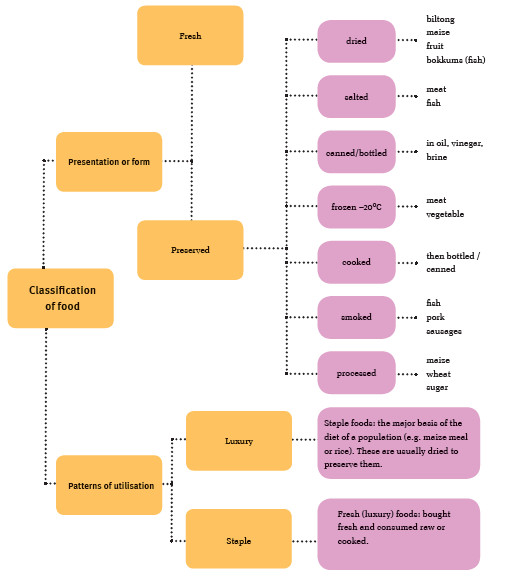
Classification of food
2.4 Impact of population change and growth on agriculture
- The highest rate of population increase (growth) was seen in the 1950s after the Second World War when it peaked at 2,2% in 1963.
- Over the last 50 years the world population has increased from 3 billion (1959) to 7 billion (2011). Population growth in Africa, Asia and South America is faster than in the developed world, resulting in a rapid increase in the demand for food.
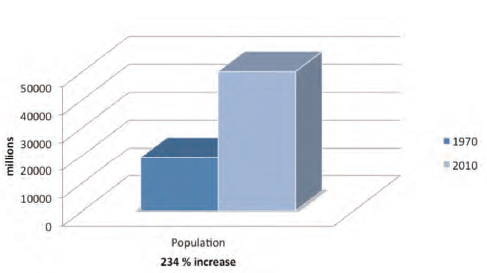
The growth in South Africa’s population
- South Africa’s population growth rate is currently 2,5% per year. This means one million extra people every year who need food. This population increase puts pressure on our food security.
- For food security to be maintained, food production must increase at the same rate as the population. However:
- in 2010, we consumed more maize that we produced. This is a staple food for many South Africans. We need a 100% increase in production by 2050.
- wheat consumption exceeded production by 60% in 2010 and will have exceeded it by over 100% by 2025.
- beef demand is set to increase by 150% and mutton by 130% if trends continue.
- similar increases in demand are expected for poultry and fresh produce.
- Migration to cities means that food supply must increase and be moved to the cities.
- In the cities, a more sedentary life style, and possibly greater wealth and education, changes the way people eat.
- There is a focus on healthy eating: less fat and more fresh fruit and vegetables; white instead of red meat.
Year | White meat (kg/year) | Red meat (kg/year) | Eggs (kg/year) | Total (kg/year) |
1970/1 | 6,24 | 43,72 | 4,07 | 54,03 |
1980/1 | 14,10 | 37,09 | 4,80 | 55,99 |
2009/10 | 32,62 | 25,14 | 8,60 | 66,36 |
The growth in demand for animal derived food over the past 40 years in South Africa
From the above table the following trends can be seen:
- The consumption of white meat has more than doubled since 1980.
- The consumption of red meat has declined by more than a third over the same period.
- The consumption of eggs has almost doubled.
- Protein intake per person per year has increased about 20% in 30 years.
- There has been a shift from red meat to white meat and eggs.
2.5 Impact of secondary and tertiary agricultural development
Secondary industries add value to the raw agricultural products. Other benefits of the secondary industries are:
- a more convenient product
- a better quality product
- a longer lasting (better preserved) product, which means less spoilage and wastage
- differentiation (segmentation) of the market, because the buyer can choose between white, brown and whole wheat bread, and low GI bread for dieters and diabetics
- stimulation of industries, such as mills, bakeries, outlets (shops of different types)
- the creation of work all along the supply chain
- the government earns more taxes from the higher prices and the additional employees
- exports may be stimulated if a really good and different product can be manufactured, such as an unusual type of health bread.
Tertiary industries spring up around agricultural products and secondary agri- industries. For example:
- The farmer, the miller and the baker all require funding from the Land Bank or other banks.
- They all require transport to move their products.
- The baker needs an advertising agency.
- All these institutions need infrastructure, such as factories or offices, and vehicles, as well as people to do the work.
Unit 3: Land Distribution and Reform
3.1 Land ownership models in South Africa
Land tenure describes the way land is held or owned. Generally, the two main forms of land tenure are titlehold and leasehold, shown in the mindmap below.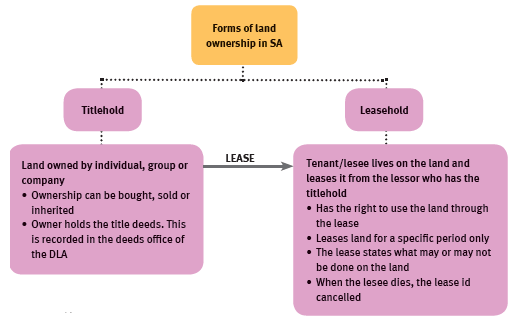
Forms of land tenure
During apartheid, land was taken away from many occupiers. So, land ownership in South Africa is complicated. There are three models of land ownership or tenure.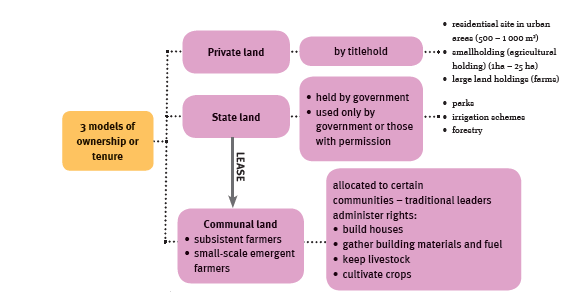
3.2 Land reform programmes in South Africa
Land reform programmes started in 1994 to transfer 30% of all agricultural land to previously disadvantaged peoples within 15 years. A three-component strategy was proposed to achieve the goal.
3.2.1 Land restitution
- Aim: to return land or provide redress to communities forced to move off their land after 1913.
- Applicants must prove that they were dispossessed to the Commission on Restitution of Land Rights, which is led by the Chief Land Claims Commissioner and the nine provincial Land Claims Commissioners, as established by the Restitution of Land Rights Act passed in 1994.
- By the end of 2008, more than 74 000 claims involving 1,4 million beneficiaries had been settled.
3.2.2 Tenure reform
The Department of Rural Development and Land Reform is busy with a Bill that will grant farm workers tenure security to their homes on the farms where they work.
3.2.3 Land redistribution programmes
- Agricultural development:
- The Land Redistribution for Agricultural Development sub-programme (LRAD).
- Previously disadvantaged persons may apply for grants to obtain land for agriculture. Persons granted money are called beneficiaries.
- To qualify, applicants must develop a business plan and provide a contribution of at least R5 000,00.
- The Settlement Land Acquisition Grant (SLAG) was put in place to encourage people to co-operate and apply as a group:
- individual contributions and the size of the grant are scaled up accordingly
- implemented as the amounts granted in the LRAD programme were small
- this programme came to an end in 2006, by which time only 3% of agricultural land had been transferred.
- The Land Redistribution for Agricultural Development sub-programme (LRAD).
- Settlement:
- Provides land to previously disadvantaged people for settlement.
- Non-agricultural enterprises:
- Provides land to previously disadvantaged people for:
- non-agricultural purposes (e.g. ecotourism)
- secondary or tertiary agricultural processing.
- Provides land to previously disadvantaged people for:
Challenges facing land reform
Progress has been slow, because of a lack of:
- funds and access to credit
- infrastructure
- expertise and training
- access to markets and marketing expertise
To address these challenges, the departments of Agriculture, Forestry and Fisheries and of Land Affairs started projects and programmes to help. For example:
- Micro Financing Initiative for South Africa (MAFISA): to provide funding to accredited Development Finance Institutions (DFIs) to lend production funding to targeted agricultural end users within targeted areas. (Was successfully piloted in Limpopo, then discontinued due to administrative complications.)
- Land and Agrarian Reform Project (LARP): started in 2008, but no funding was allocated to this programme, so it never got off the ground.
- The Comprehensive Agricultural Support Programme (CASP): is intended to provide post- settlement support to beneficiaries of land reform. This programme has had a good impact but has limited funding.
- Proactive Land Acquisition Strategy (PLAS): is functional and making an impact, although it is hampered by insufficient funding.
Unit 4: Agricultural Legislation
4.1 The aims of agricultural legislation
The aims of agricultural legislation are to:
- enforce the provisions of the Constitution
- promote agricultural production
- regulate all sections of the agricultural sector so that they contribute to the functioning of the state, to food security and to the economy and welfare of people
- form the legal framework for running the agricultural sector
- prescribe the framework for good agricultural practices
- protect our natural resources from exploitation, pollution and degradation
- protect workers from exploitation, unfair discrimination and abuse.
There are also specific laws with specific aims, such as
- control introduction of plants and livestock diseases and parasites into South Africa
- managing disease outbreaks
- controlling the safety and quality of our food
- controlling the selling and marketing of agricultural produce.
4.2 The legal concepts
- The Constitution:
- The Constitution is the supreme law of the land. It provides the basic principles with which all other laws must comply.
- Green paper:
- A green paper is a preliminary report on a government proposal for a new or amended law. It is published to stimulate discussion before legislation is written and published. It gives suggestions for public debate and consultation, which are then used to draft a law.
- White paper:
- When the government proposes a law, it is published as a white paper to give people the opportunity to comment. Then the law is drafted and presented to parliament for consideration. If it is accepted, it is passed by parliament and becomes a law.
- Regulations (by-laws):
- Laws are broad in concept and lack detail. As time passes, the detail changes and so regulations are published from time to time to fill in the appropriate detail. Regulations are promulgated by the minister and do not need to go back to parliament for consideration.
- Amendments:
- When a law becomes out-dated due to changing circumstances, it is amended.
4.3 Important laws which affect agriculture
Some of the main laws in South Africa that affect agriculture are summarised below.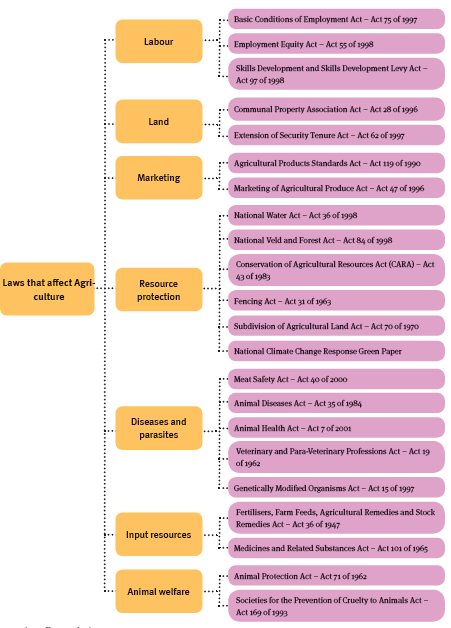
Laws that affect Agri- culture
Unit 5: Agricultural Organisation
5.1 Levels of agricultural organisations
Agriculture is organised and managed by the government and by private industry bodies at national, provincial and local levels.
5.1.1 The role of government
Because agricultural development is vital to our country, the government – through its various structures at different levels – manages it.
run and maintain research factilities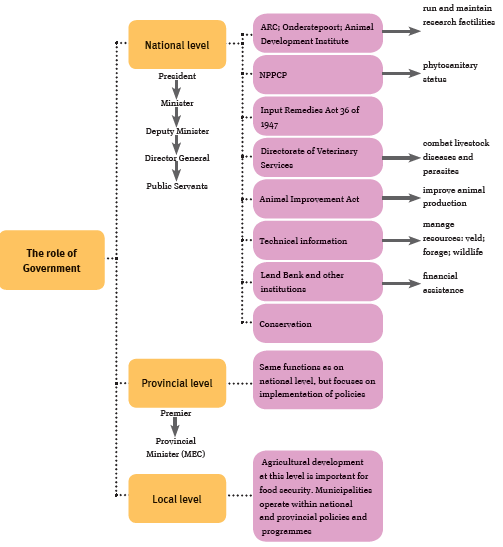
The role of government in agriculture
5.2 The roles of agricultural organisations
Community-based organisations are made up of farmers and stockowners who join together in a union. They operate on local, provincial and national levels. Organisation is from the bottom up: from local to national levels, e.g. Agri-SA. Each level will negotiate with the governmental structures at its appropriate level. So the national farmers’ unions act as the mouthpiece for all farmers at national level.
5.2.1 Aims
- National level: to ensure the best financial and social position for the farmer within the national economy
- Local and provincial level: issues specific to a region, e.g. bad roads, security and communications.
5.2.2 The Agricultural Research Council (ARC)
- The ARC was established in 1990 through the Agricultural Research Act, Act No. 86 of 1990.
- The ARC is the principal agricultural research institution in South Africa.
- It runs 12 research institutions and most experimental farms, which carry out research into important aspects of agriculture.
There are four research focus areas.
- Horticulture
- ARC Institute for Tropical and Subtropical Crops (Mbombela/Nelspruit):
- handles the cultivation tropical and subtropical fruits, as well as tea, coffee, spices, pecan nuts, Macadamia nuts, and cashew nuts. Exotic crops are also evaluated, including cacao, coconut, annona (custard apple) types, and sapote (ShuShu).
- ARC Roodeplaat Vegetable and Ornamental Plant Institute (Pretoria):
- works on commercial and indigenous vegetables. It also researches the production and development of ornamentals and indigenous flora such as fynbos and on natural products and medicinal plants.
- ARC Infruitec-Nietvoorbij (Stellenbosch):
- focuses on deciduous fruit, alternative crops (e.g. berries, figs and olives), indigenous herbal teas, and regional medicinal plants. Attention is paid to extending the shelf life of agricultural products, with a focus on post-harvest processes, such as wine and brandy production, as well as cold storage, drying, canning, juicing and jam production.
- ARC Institute for Tropical and Subtropical Crops (Mbombela/Nelspruit):
- Animal production and health
- ARC Onderstepoort Veterinary Institute (OVI) (Onderstepoort, Pretoria):
- focuses on veterinary research to improve the understanding of the diseases and parasites affecting our livestock as well as on improving the production of vaccines and diagnostic tools. They also produce vaccines against redwater, heartwater and gallsickness.
- ARC Animal Production (Irene, Gauteng):
- focuses on technologies to improve the quality of animals, and on developing genetic and physiological methods to identify and study superior livestock breeding material in order to improve the efficiency and production of our national herd. They also study the nutritional needs of animals in order to enhance the quality of meat and dairy products, and different holistic and integrated land use and management strategies to ensure sustainable utilisation of our land resources.
- ARC Onderstepoort Veterinary Institute (OVI) (Onderstepoort, Pretoria):
- Natural resources and engineering
- ARC Soil, Climate and Water (Pretoria):
- studies characterisation, sustainable utilisation and protection of natural resources. Its research includes soil science, agro-meteorology, water utilisation and water analytical services.
- ARC Engineering (Pretoria):
- the engineers focus on agricultural mechanisation, irrigation and alternative energy, and the innovation of energy sources and application in rural areas, such as the use of methane gas from manure or compost to cook food.
- ARC Plant Protection Research Institute (Pretoria):
- handles the control of pests through effective pesticide management, and biological and integrated control strategies. They also research and help rural communities with bees and honey production.
- ARC Soil, Climate and Water (Pretoria):
- Grain and industrial crops
- ARC Grain Crops Institute (Potchefstroom):
- works towards the improvement and cultivation of summer grain crops (e.g. maize, sorghum and millet) and oil and protein seeds (e.g. sunflowers, groundnuts, soya beans, cow peas lupins and Bambara). Research focuses on plant breeding, the evaluation of cultivars, grain quality and entomology.
- ARC Small Grain Institute (Bethlehem):
- focuses on the improvement and cultivation of small grain crops (winter grains) such as wheat, barley, oats, rye and Triticale, and covers the same aspects of research on these crops as the above institute does, only on small grains.
- ARC Institute for Industrial Crops (Rustenburg):
- researches cotton and tobacco, as well as industrial crops such as hemp, sisal, flax and cassava. It also researches the re-introduction of indigenous crops such as cowpeas, Bambara, millet and sorghum.
- ARC Grain Crops Institute (Potchefstroom):
5.2.3 National Agricultural Marketing Council
The National Agricultural Marketing Council (NAMC):
- was established by the Marketing of Agricultural Products Act, Act No. 47 of 1996
- with the mission to:
- provide policy and strategy recommendations to the Minister (DAFF).
- focus on the optimising the strategic position of the South African agricultural sector in dynamic global markets.
- supply information on the marketing of South African agricultural products.
There are four divisions:
- Market and Economic Research Centre (MERC):
- researches and tries to understand agro-food market chains (including cost of inputs and selling prices – local and global), trade, risk management and information systems.
- Agricultural trusts:
- MERC was appointed in 2008 to manage the reporting on agricultural trusts. There are numerous agricultural trusts with mandates to promote all aspects of each specific industry, e.g. Citrus Trust, Cotton Industry Trust, Deciduous Fruit Industry Development Trust and the Maize and Meat Trusts.
- Agribusiness development:
- this division collaborates with industries to design programmes to improve market access and encourage new business development in previously disadvantaged agribusiness.
- Statutory measures:
- the Act provides for statutory measures such as levies, control of exports and the collecting, keeping and registration of agricultural exports.
5.2.4 Council for Scientific and Industrial Research (CSIR)
- The CSIR was established by an Act of parliament in 1945 = South Africa’s main scientific and technical research organisation.
- Research focuses on many sectors of the economy with the aim to improving the quality of people’s lives.
- Its industrial and other programmes are run by the Department of Science and Technology:
- can impact and assist in the improved delivery of agricultural products through the study of climate change, sustainable energy, forestry resources, pollution, and waste and ecosystems.
5.3 Benefits and advantages of agricultural organisations
5.3.1 Government organisations
- The Department of Agriculture, Forestry and Fisheries protects and assists farmers and stockowners through laws.
- Research findings from the ARC, CSIR and others benefit farmers, e.g. new vaccines, new development of cultivars or crops (e.g. peppadews)
- The National Agricultural Marketing Council (NAMC) provides information on the latest pricing trends of products, both locally and internationally.
5.3.2 Community-based organisations
- Agri-SA gives a voice to all farmers from local and regional chambers, to national level through contact with DAFF.
- The Agricultural and Veterinary Chemicals Association (AVCASA), through its subsidiaries: Crop Life, The South African Animal Health Association (SAAHA), and the Agricultural Chemicals Distributors of South Africa (ACDASA), is a voluntary association of private companies that provide inputs such as agricultural remedies. They provide training on the safe use of chemicals.
Unit 6: Indigenous Knowledge in South Africa
6.1 Indigenous (traditional) knowledge systems
Indigenous (traditional) knowledge systems (IKS) are knowledge systems passed down by word of mouth over hundreds (and even thousands) of years, based on people’s close interaction with the environment. Much of this information is useful and is being tested scientifically by scientific or evidence-based knowledge. Indigenous knowledge is now being used in agriculture and medical science.
Scientific knowledge | Indigenous knowledge |
Modern (couple of hundred years) | Old (thousands of years) |
International | Local |
Not necessarily suitable for African conditions | Developed in Africa for local conditions |
Written and accurately recorded | Passed on by word of mouth (verbal) |
Proven by scientific testing | Determined by observation |
Accurate analyses and dosing | Dosing determined by trial and error |
In some cases may place stress on environment | Generally adapted to the environment |
Suitable for mass production | Only suitable for sustainable harvesting |
Comparison of indigenous and scientific knowledge
6.2 Indigenous knowledge used in agriculture
6.2.1 Indigenous livestock breeds
- Meat, milk and eggs:
- Indigenous animal breeds are better adapted to the climate, they have a smaller impact on the environment and they are more resistant to many of our indigenous diseases and parasites. Examples are Nguni cattle, Pedi sheep, the indigenous goat and various chicken breeds such as the Venda, Ovambo and Zulu chickens.
- They are suitable for subsistence farming where there is no focus on production.
- Crossbreeding:
- They have specific traits that are good and these are used in crossbreeding to improve the survivability of the modern, imported breeds that have been selected for production traits. Examples of such crosses are the Boer Goat, (which is exported all over the world because of its good characteristics), the Kalahari Red goat, the Dorper sheep, Afrikaner cattle and the Boschvelder layer chickens.
- Game animals:
- Even better adapted to our environment and its challenges (water shortages, diseases like, and parasites like ticks).
- Because of their scarcity, they are considered a delicacy, their meat fetching high prices overseas.
- This is a unique opportunity that SA is still not fully utilising.
6.2.2 Indigenous vegetation
- Construction and manufacturing:
- Indigenous peoples know which grasses, sedges and reeds are suitable for basket weaving, for the construction of shelter, for fishing nets and utensils such as brooms and place mats.
- Medicine:
- Many indigenous plants have been identified through indigenous knowledge as having medicinal effects:
- Hoodia gordonia (bitter ghaap) is a leafless succulent with large pale grey/ pink flowers. It grows in the dry western parts of South Africa. It was traditionally used to suppress hunger and thirst. Scientific analysis has identified an active ingredient called P57, and scientific testing has shown an appetite suppressant effect that acts on the brain. An extract of Hoodia is sold commercially to help people diet. Because it is a desert plant, it is not very numerous and it cannot sustain wild harvesting, so large-scale cultivation has been initiated.
- Hypoxis hemerocallidea, (African potato, or inkomfe in isiZulu) is a perennial with long green leaves and yellow star-shaped flowers. Traditionally, it was used for the treatment of enlarged prostate glands. Modern analytical methods have extracted the ingredient beta-sitosterol. It is now grown commercially and used in products in Europe to treat prostate enlargement and as an immune stimulating tonic.
- Sutherlandia frutescens (cancer bush, or phetola in Setswana) is a shrub with a silvery appearance and red flowers. It is found all over South Africa, Lesotho and Botswana. Studies show that it has an active ingredient called canavanine, which has anticancer activities. It has also been reported to be effective in helping people with TB and who are HIV-positive.
- Lippia javanica (fever tea, or inzinziniba in isiXhosa; umsuzwana in isiZulu) is a tall shrub with hairy green leaves and a strong lemony smell. It is now cultivated to extract oil used in mosquito repellent candles.
- Powdered bark of Albiza adianthofolio and A. anthelmintica (false paperbark, or umhlandlothi in isiXhosa; umgadankawu in isiZulu) was used widely to treat tapeworm in livestock.
- Many indigenous plants have been identified through indigenous knowledge as having medicinal effects:
6.2.3 Food and drink
- Some indigenous food crops are being improved, for example, Bambara bean, the cowpea, millet and sorghum. Amadumbe is an indigenous plant that produces a tuber that is used like a potato.
- Various indigenous herbs are used to produce medicinal and non-medicinal teas, for example, Rooibos, Honey bush (anticarcinogenic) and Boegoe / buchu tea (anti- ageing and diuretic properties).
6.3 Constraints and advantages of indigenous knowledge
6.3.1 Constraints
- Indigenous knowledge was not written down and recorded and was sometimes inaccurately passed on, and folklore added.
- Measurement and analyses of the active ingredients could not be done, so the dosing is inaccurate.
- The knowledge has not necessarily kept pace with the demands of a growing population, rapidly increasing demand, and the consequent need for focus on productivity.
6.3.2 Advantages
- Thousands of years of knowledge and experience can be accessed.
- There is information on where to look and what research to do to prove or disprove the claims.
- The gene pool has not been interfered with, so it is broader than that of ‘developed’ European breeds. This ensures the benefits of biodiversity are there when we need them.
- Local breeds are better adapted to local conditions and have less impact on the environment.
- The use of indigenous crops benefits biodiversity, counters malnutrition, and improves food security and soil fertility.
6.4 Protection and management of IKS in South Africa
- The Department of Agriculture, Forestry and Fisheries recognises the benefits of conserving and investigating indigenous knowledge.
- Some of its divisions have specific programmes to investigate and record this information.
- Many of the ARC Institutes are gathering, researching, recording and storing this information.
- Both government and private institutions, like the Breed Society, are preserving the genetic material of these breeds and cultivars.
- Some of the national and multinational pharmaceutical companies researching IKS to find new medicines for diseases, such as malaria.
Topic 2: Questions
- Answer the questions below.
- Give yourself one hour.
- Check your answers afterwards and do corrections.
Questions
- Name five main concerns in Agricultural Economics. (5)
- Discuss four modern challenges faced in agriculture. (12)
- Over the past four decades there has been a shift in the eating patterns of South Africans. In what ways did these eating patterns change and why
did they change? (10) - Describe the three models of land ownership in South Africa. (9)
- Name three important laws that affect agriculture. (6)
- Name the main three agricultural organisations in South Africa and briefly describe the main functions of each. (9)
- Give four differences between scientific knowledge and indigenous knowledge (IK). (8)
- Name three indigenous medicinal plants.
- Discuss four advantages to using IK in agricultural production. (8)
[Total marks: 70]